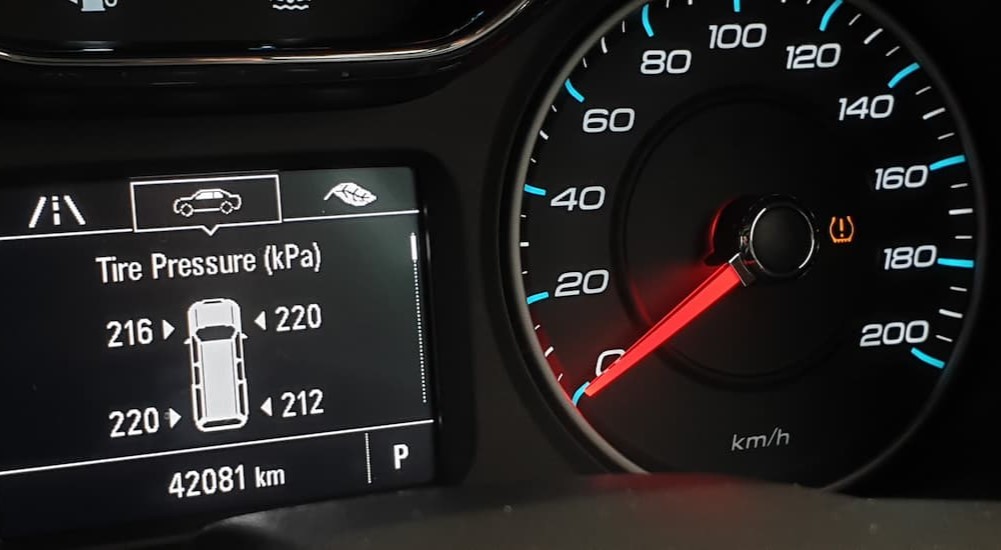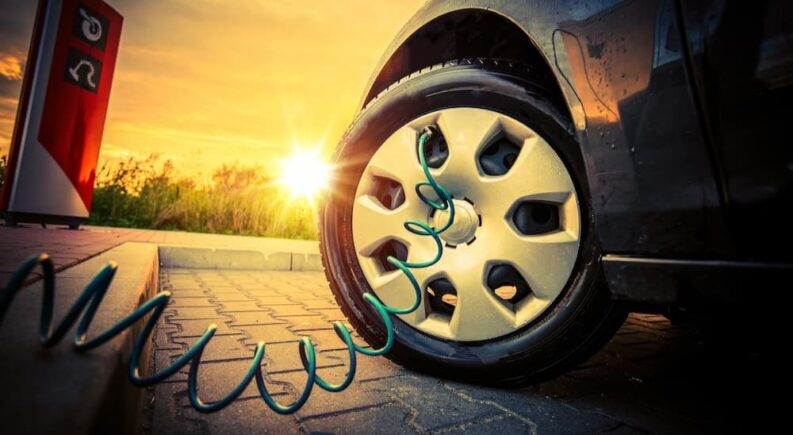Along with refilling the windshield washer fluid and checking the dipstick, using a tire pressure gauge is often one of the first basic car maintenance tasks that every driver will learn. When compared to changing your oil, rotating your tires, and replacing belts and filters, this simple chore might seem relatively inconsequential, but that couldn’t be further from the truth. In reality, a set of properly inflated tires can have a huge impact on the overall driving experience, affecting everything from fuel economy and ride comfort to safety, performance, and tire wear. With the advent of modern tire-pressure monitoring systems (TPMS), regularly checking a vehicle’s tire pressure isn’t as common as it once was, but a little refresher never hurts. Join us as we explore what you need to know about tire pressure, compare TPMS options, look at some common pressure-related symptoms, and learn how a set of properly inflated tires can make all the difference on your next drive.
Max PSI vs Recommended PSI
The first step in checking your tire pressure doesn’t involve your tires at all but rather your glovebox. There, you’ll find your vehicle’s owner’s manual, which will list the recommended tire pressure for both the front and back tires. This information can also be found on the sticker affixed to the driver’s side door jamb, which will also list some other important metrics like tire size and gross vehicle weight rating (GVWR). Historically, some drivers have skipped this step and opted to use the PSI stamped into the side of a tire. There’s only one problem with that approach: the PSI listed on the tire is its maximum PSI, not the level it should be inflated to on a regular basis. It’s an easy mistake to make, so make sure to reference your owner’s manual or the door sticker if you want to avoid cruising around town on overinflated tires.
How to Check Tire Pressure
Once you’ve confirmed your vehicle’s recommended PSI, it’s time to grab a tire pressure gauge. There’s nothing wrong with the classic $2, pocket-friendly pencil gauge, but if you feel like making an upgrade, there are also plenty of affordable alternatives, including digital options, available for $15 or less. Start by unscrewing the cap from the air valve and storing it somewhere safe. Once the cap is removed, press the tire pressure gauge against the valve until you hear a hiss of air. Keep the gauge tightly adhered to the tire until this hissing sound stops, and then read the gauge. On an old-fashioned pencil gauge, a plastic bar will extend from the base of the metal cylinder and stop at the current PSI. More advanced gauges might display the PSI on a round dial or, in the case of digital tire pressure gauges, an LCD screen.
If the number displayed falls within a couple PSI of the recommended number, you’re good to go. If the number is more than four PSI higher or lower than the recommended number, consider topping off your tires or letting out a little air. It’s important to note that temperature can have a noticeable effect on tire pressure, which is why it’s always best to check your tires first thing in the morning before you’ve done any driving. If you’re checking your tires on a particularly hot day, you might get a reading that is a little higher than normal, and colder days could lead to a lower PSI. As you drive your vehicle and the tires start to warm up, it’s not uncommon to gain as much as 4 PSI within the first 15 to 20 minutes of driving. This number is usually too small to have a significant impact on performance or fuel efficiency, but it’s always good to keep in mind when calibrating your tires.
Tire Pressure Monitoring Systems
All new vehicles take the guesswork out of tire inflation with a handy feature known as a tire-pressure monitoring system. The first TPMS system debuted on the 1987 Porsche 959 and the technology was reserved for luxury and performance models for many years. However, the feature has been required in all new vehicles since 2007 as part of the Transportation Recall Enhancement, Accountability, and Documentation (TREAD) Act, allowing a wide swath of drivers to enjoy this important safety and performance feature. While TPMS is used as a general term for these monitoring systems, some brands have introduced their own branded offerings, such as Ford’s Deflation Detection System (DDS) and Honda’s Deflation Warning System (DWS).
If you’ve ever noticed a dashboard indicator that looks like a melted horseshoe or a cauldron with an exclamation point in the center, you’re already familiar with TPMS. If the TPMS detects an underinflated tire, it illuminates this dashboard light, potentially saving drivers from a dangerous mid-ride blowout. Some newer TPMS options can pinpoint the issue to a specific tire, but in most cases, the driver still has a little legwork to do. When the TPMS is activated, drivers still need to pull out their trusty tire pressure gauge and give each tire a quick check. If the problem is severe, drivers should be able to spot the underinflated tire at a glance, but it never hurts to use an illuminated TPMS as an excuse to check all four.

Direct vs Indirect TPMS
TPMS comes in two forms: direct and indirect. Direct TPMS relies on a system of sensors installed within each individual tire, which can be used to measure both pressure and temperature to ensure you’re always rolling on properly inflated tires. Indirect TPMS, on the other hand, relies on a series of external sensors that measure wheel speed. These sensors are also an important part of a vehicle’s anti-lock brake system, but unlike direct TPMS, they’re not actually located inside the tires. If a wheel starts rotating at a faster rate than normal, indirect TPMS interprets that as the tire being underinflated and sends an alert to your vehicle’s onboard computer.
Direct TPMS offers a number of advantages over indirect systems. Primarily, it’s a matter of accuracy. Since direct TPMS uses actual air pressure monitors within the tires, it tends to be more accurate than indirect offerings, which can be thrown off by a number of factors, such as uneven tire wear and extreme temperatures. Direct TPMS does come with its downsides. First off, it tends to be more expensive than its indirect counterparts and must be resynchronized every time you perform a tire repair or replacement. The batteries that power a direct TPMS sensor can last up to 10 years, but when they do go, it often necessitates wholesale replacement of the sensor at $50 to $100 a pop. If you value ease of use and lower lifetime maintenance costs, you might want to track down a vehicle with indirect TPMS. If accuracy is the name of the game––and money is no object––a direct TPMS is the way to go.
Symptoms of Improperly Inflated Tires
Most drivers don’t give their tires much thought until something goes wrong, and it can be all too easy to become accustomed to improperly inflated tires. While TPMS can go a long way in addressing this issue, it should be looked at as a last line of defense. By the time TPMS bothers to throw up a warning light, your tires could already be running 25 percent lower than the recommended PSI, especially when it comes to the less accurate indirect TPMS. So, how’s a driver to know when their tires are a little overinflated or underinflated? There are a few common symptoms to keep an eye on.
Overinflated Tires
Poor Traction
In order for tires to work their best, they have to make an appropriate amount of contact with the road. When tires are inflated above the manufacturer’s recommended PSI, the tire’s contact patch can become too small to grip the road effectively. This can lead to a noticeable loss in traction, which can be especially dangerous during a rainstorm or the winter months when encountering wet or snowy road conditions.
Wear on Center Treads
The way a tire’s tread wears can tell us a lot about the state of the vehicle and the tire itself. If you’re riding on overinflated tires, you might notice that the tread towards the center of the tire is wearing out much more quickly than the rest of the rubber compound. Alignment, balance, and suspension issues can also lead to odd wear patterns in the tread, but a smooth strip along the center of the tire is a surefire sign that you’re dealing with an overinflated tire.
Bumpy Ride
A rough, bumpy ride is another common sign of overinflated tires. When you run your tires above the recommended PSI, they tend to be a little more unforgiving when it comes to ride comfort. Overinflated tires are simply harder than properly inflated tires, meaning they lose much of their shock-absorbing qualities.

Underinflated Tires
Poor Fuel Economy
Keeping your tires at the right pressure can be one of the easiest ways to improve overall fuel economy. The more contact the tires make with the road, the more effort the vehicle has to put into pushing itself down the road, which translates directly into fuel economy. An underinflated tire means wasted energy and can lower gas mileage by around 0.2 percent for every PSI it is off. Properly inflated tires can improve gas mileage by several percent, which is why it’s so important to do a monthly PSI check.
Sloppy Handling
Running a vehicle with low PSI can cause the tire’s sidewalls to slump and contract, which is not ideal if you value control and safety. A sagging sidewall can throw a vehicle’s driving dynamics all out of whack and decrease responsiveness, creating a dangerous situation for everyone on the road when it comes time to corner or steer.
Less Effective Braking
Underinflated tires can lead to a loss in braking power. While this is also true of overinflated tires, the issue tends to be more noticeable on underinflated tires. Underinflated tires simply flex a little more than they’re supposed to, which means that they’re not as effective when it comes to bringing your vehicle to a stop. No one enjoys an auto accident, but earning a hefty repair bill and higher insurance premium because you couldn’t be bothered to whip out the old tire pressure gauge is an especially harsh learning experience.
Don’t Neglect Your Tire Pressures
Thanks to TPMS, today’s tires are smarter than ever, but that’s no excuse to let your regular tire pressure maintenance schedule fall by the wayside. It’s easy to outsource your pressure-related anxiety to a modern TPMS, but as we mentioned, these systems are often not the quickest way to alert a driver to a problem. Drivers should ideally check their tire pressures at least once a month or at least make sure to give them a once-over before any long road trips or periods of extended driving. Keeping track of your fuel economy is another way to spot an underinflated tire, though the change will often be too subtle for all but the most eagle-eyed drivers to notice. Keep an eye on your tread wear pattern, and always make sure to calibrate your tire pressure according to the recommended PSI, not the max PSI stamped into the tire. We can’t always control some of the risks associated with the open road, but regularly checking your tire pressures and keeping all four tires properly inflated is an easy way to improve your chances of a successful journey.

